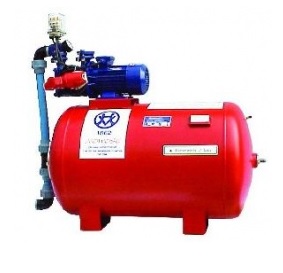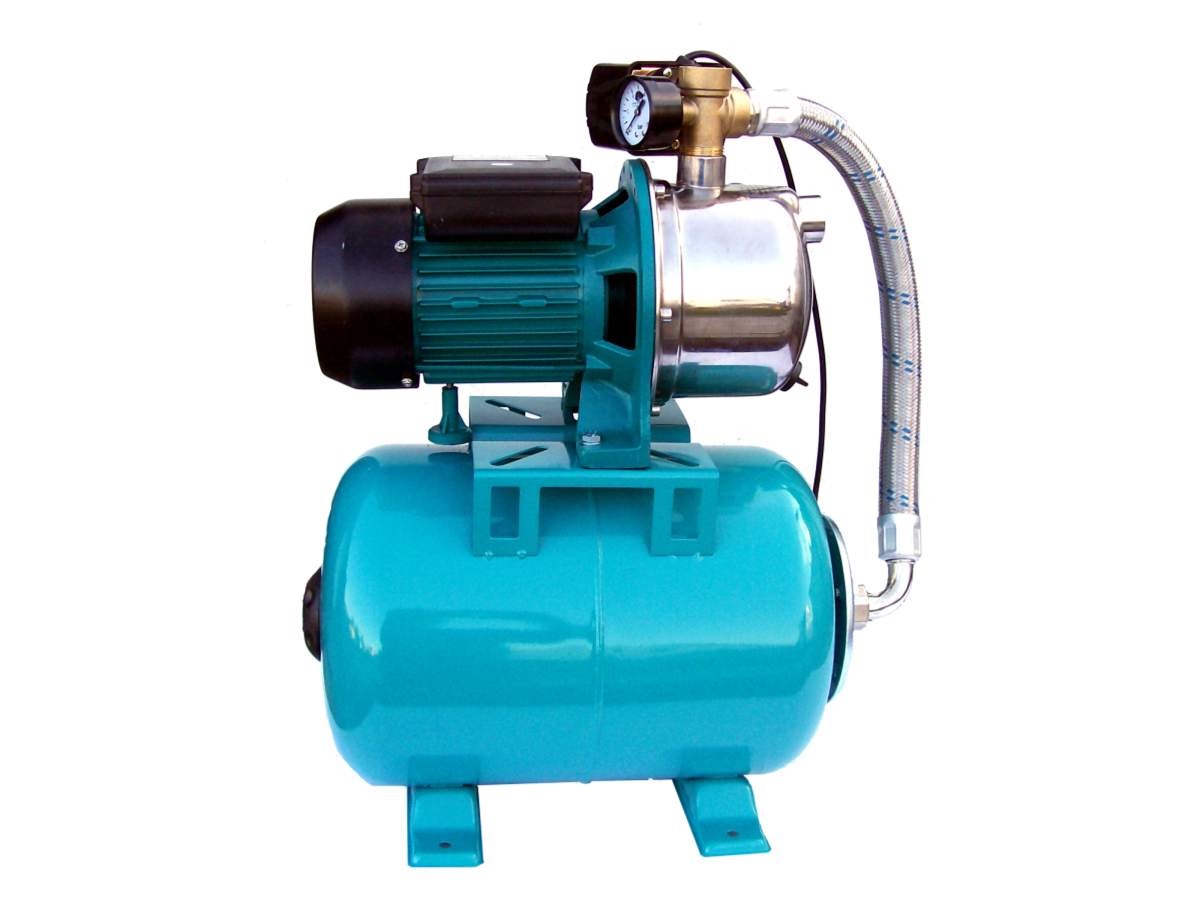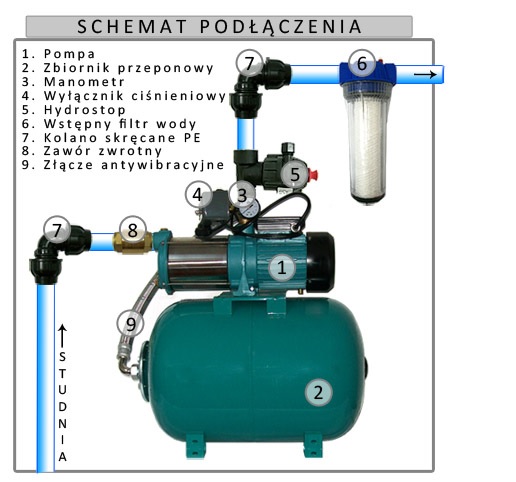- favorite 4 likes
- remove_red_eye 48759 views
- comment 0 comments

CHOOSING A HYDROPHORE SET FOR THE HOME
A hydrophore or a hydrophore set is a device whose task is to stabilize the pressure in the water system. The hydrophore also prevents the water pump from turning on and off too often and makes it possible to use water flowing with an equally intense stream from all taps in the house. The hydrophore system consists of a pressure tank for water, a discharge pump and a pressure switch. The task of the hydrophore is to provide and maintain proper water pressure in the building's water supply system.
These devices consist of at least one pump, pressure vessel, pressure switch and valves (shut-off, return and safety devices). The number of pumps installed in a system depends mainly on the size of the network. The size of the tank and the pump capacity should be adapted to the water consumption in a given household. The greater the consumption, the larger the tank and the more efficient pump should be selected. If the capacity of the tank is too small, the pump will work almost all the time, which will shorten the life of its engine and contribute to an increase in electricity bills. Each pump has a strictly defined number of cycles of its work within one hour. Pumps that are used in single-family homes generally have cycles of 20 to 30 per hour. . More frequent activation of the pump than provided for by the manufacturer may cause its destruction and the necessity to replace it with a new one. The task of the pressure booster system is therefore to limit the number of pump starts and thus extend its downtime. This is due to the accumulation of pressure in the hydrophore tank and the accumulation of water sufficient for consumption there when the pump is not working. A hydrophore is needed in an installation supplied with water from its own well, but it may also prove useful when the installation is connected to a water supply (when the pressure at the connection point is not high enough, so that the uppermost tier taps cannot be supplied with sufficient water) or when it is drawing water from non-pressurized tanks (for example collecting rainwater).
Traditional hydrophore sets
Older type of hydrophore sets are still commonly used in single-family houses. The tanks of such sets are relatively large and usually cooperate with self-priming centrifugal pumps. To install them, you need a suitable room, and for efficient operation - proper maintenance and periodic adjustment.
The room where it will be possible to install a traditional hydrophore must have dimensions of 2 x 2.5 m in plan and a height of 2.5 m.
The operation of traditional hydrophores can be troublesome mainly due to the quite loud operation of the pump. However, if the device suddenly becomes louder than before - check that there is no air in the suction line and bleed the pump, if necessary. In traditional hydrophores, there may also be air losses in the tank. This is generally because oxygen is dissolved in the water. In this case, it is necessary to refill the airbag periodically to prevent the pump from activating too often.
Another disadvantage associated with the use of a traditional hydrophore set is the so-called rotting water in the tank. Most often, this process occurs when the water contains humic compounds and is kept in the tank for a long time. This usually applies to tanks that act as backup tanks for supplying the domestic installation during mains water interruptions. Then the only method to prevent the unpleasant phenomenon is frequent emptying of the tank and cleaning it. Older types of tanks usually have a capacity of 100 to 300 l, which in many cases makes their disassembly and thorough cleaning impossible, therefore they have a special viewing window through which it is possible to clean the tank without unnecessary manipulation.
Pressure regulation
The maximum water pressure in the tank is 3 bar. It is very important to set the operation of the pressure booster system correctly. Determine the maximum and minimum pressures needed to operate the pump. The pressure booster system should run smoothly and as required. For this to happen, it is also necessary to determine the amount of air that will pump water with the required pressure in the system. The air cushion in the hydrophore should occupy 1/3 to 3/4 of the volume of the tank, with its maximum filling with water. Otherwise, it can only constitute technical documentation of given models of hydrophores.

Modern hydrophore sets
They are characterized by the so-called compact design, which means that they are much smaller and do not require special rooms for their installation. They can often be placed in an ordinary cabinet under the sink. The pressure tank of a modern hydrophore is equipped with a tight rubber membrane that separates the water from the airbag. It can be both horizontal and vertical. Most often it is mounted above or below the pump - creating free-standing and space-saving sets. Modern hydrophore sets work much quieter than devices in the traditional version. This directly contributes to the full comfort of their use and the growing interest in their purchase. In general, modern sets are equipped with electronic regulators, which eliminates the need for manual setting. They are only included in the installation and use them to draw water. You just have to remember that the membrane material and the inner lining of the tank should have a certificate allowing them to come into contact with drinking water issued by the National Institute of Hygiene.

Selection of hydrophore elements
When choosing a hydrophore that is right for us, more than a brand, we should take into account the possibility of adapting the device to our own needs. Hydrophores are installed primarily as elements of home water supply networks. Therefore, the area of our single-family house, the number of people using clean water and the number of water intake points are becoming important. The greater the consumption, the more capacious the hydrophore tank must be.
After taking into account these mentioned factors, it is possible to estimate what hydrophore and pump we will need. If our house does not have a large area, and water intake points are located in the kitchen (sink and dishwasher), bathroom (washbasin, bathtub or shower cubicle, toilet), laundry room, it is assumed that the demand may be about 0.69 l/s . Converted into hours and cubic meters, it will be 2.5 m3/h.
If, on the other hand, the house has a large area and there are more draw-off points, for example because there are two bathrooms planned, the clean water requirement will be 0.84 l/s, which is 3.0 m3/h. In such cases, the pump power must be much greater. Similarly - the efficiency of the hydrophore, which will be forced to switch the pump on more often. Much more water will flow through the hydrophore tank.
These values will increase in the case of a large number of household members. Experts estimate that about 150 liters of clean water are consumed daily for one person, which, with a large family, can give a really large consumption. Of course, these are only estimates, however, according to such calculations, the expected water consumption is taken into account and appropriate devices are selected.
Diagram of an exemplary hydrophore connection

We invite you to familiarize yourself with the store's assortment, where you will find all the elements to create a hydrophore or ready-made solutions. If you have any questions, please contact us by phone or e-mail.

Comments (0)